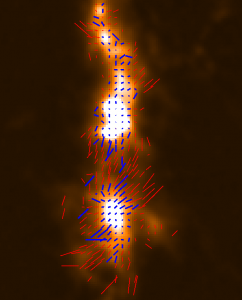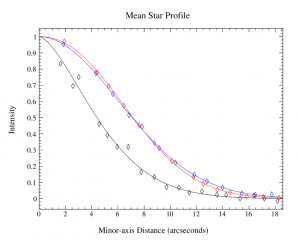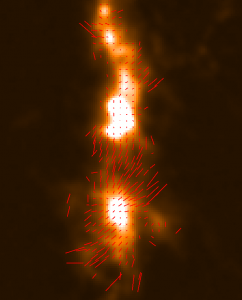A new parameter called SMOOTH450 has been added to the pol2map script (used for processing POL2 data). It is only accessed when processing 450 um data and defaults to False, which results in no changes to the behaviour of pol2map. If SMOOTH450 is set to True, pol2map performs an additional smoothing that results in the resolution of the resulting I, Q and U coadds (and the vector catalogue) being degraded to the resolution expected for 850 um data. This allows 450 and 850 um results to be compared more easily. A side-effect of the smoothing is that the noise levels in the final 450 um maps and catalogues is lower.
The smoothing is applied to the I, Q and U maps made from each individual observation before using them to form the I, Q and U coadds. The same smoothing kernel is used for I, Q and U and is formed by deconvolving the expected 850 um beam shape using the expected 450 um beam shape as the PSF (Point Spread Function). The “expected” beam shapes are two-component Gaussians as described in “SCUBA-2: on-sky calibration using submillimetre standard sources” (Dempsey et al, 2013, MNRAS, 430, 2534).
The following plot shows the the mean radial total intensity profile of 3C279 determined from 25 POL2 observations. The black curve shows the 450 um profile produced using SMOOTH450=NO (the default), the red curve shows the 450 um profile produced using SMOOTH450=YES and the blue curve shows the 850 um profile. It can be seen that the smoothed 450 curve is very similar to the 850 curve.
The following vector maps shows 450 um vectors created from four observations of DR21. The blue vectors were created with SMOOTH450=NO and the red vectors with SMOOTH450=YES (for comparison, the right hand map shows the same red vectors without the blue vectors). Both red and blue used the same selection criterion (i>5*di && dp <0.5 && dang < 10). The main difference is that there are many more red vectors than blue vectors. This is because the smoothing introduced by SMOOTH450 has reduced the noise level, thus allowing more vectors to pass the above selection criterion.





